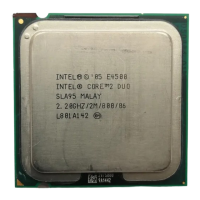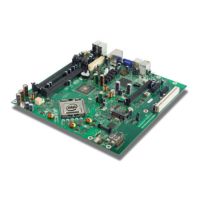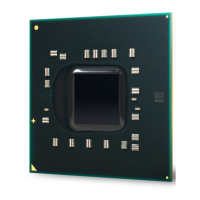Errata
64 Intel
®
Core™2 Extreme Processor X6800 and
Intel
®
Core™2 Duo Desktop Processor E6000 and E4000 Sequence
Specification Update
AI118. VM Exit with Exit Reason “TPR Below Threshold” Can Cause the
Blocking by MOV/POP SS and Blocking by STI Bits to be Cleared in
the Guest Interruptibility-State Field
Problem: As specified in Section, “VM Exits Induced by the TPR Shadow”, in the Intel
®
64 and IA-32 Architectures Software Developer’s Manual, Volume 3B, a VM
exit occurs immediately after any VM entry performed with the “use TPR
shadow", "activate secondary controls”, and “virtualize APIC accesses” VM-
execution controls all set to 1 and with the value of the TPR shadow (bits 7:4
in byte 80H of the virtual-APIC page) less than the TPR-threshold VM-
execution control field. Due to this erratum, such a VM exit will clear bit 0
(blocking by STI) and bit 1 (blocking by MOV/POP SS) of the interruptibility-
state field of the guest-state area of the VMCS (bit 0 - blocking by STI and bit
1 - blocking by MOV/POP SS should be left unmodified).
Implication: Since the STI, MOV SS, and POP SS instructions cannot modify the TPR
shadow, bits 1:0 of the interruptibility-state field will usually be zero before
any VM entry meeting the preconditions of this erratum; behavior is correct
in this case. However, if VMM software raises the value of the TPR-threshold
VM-execution control field above that of the TPR shadow while either of those
bits is 1, incorrect behavior may result. This may lead to VMM software
prematurely injecting an interrupt into a guest. Intel has not observed this
erratum with any commercially available software.
Workaround: VMM software raising the value of the TPR-threshold VM-execution control
field should compare it to the TPR shadow. If the threshold value is higher,
software should not perform a VM entry; instead, it could perform the actions
that it would normally take in response to a VM exit with exit reason “TPR
below threshold”.
Status: For the steppings affected, see the Summary Tables of Changes.
AI119. Using Memory Type Aliasing with Cacheable and WC Memory Types
May Lead to Memory Ordering Violations
Problem: Memory type aliasing occurs when a single physical page is mapped to two or
more different linear addresses, each with different memory types. Memory
type aliasing with a cacheable memory type and WC (write combining) may
cause the processor to perform incorrect operations leading to memory
ordering violations for WC operations.
Implication: Software that uses aliasing between cacheable and WC memory types may
observe memory ordering errors within WC memory operations. Intel has not
observed this erratum with any commercially available software.
Workaround: None identified. Intel does not support the use of cacheable and WC memory
type aliasing, and WC operations are defined as weakly ordered.
Status: For the steppings affected, see the Summary Tables of Changes.

